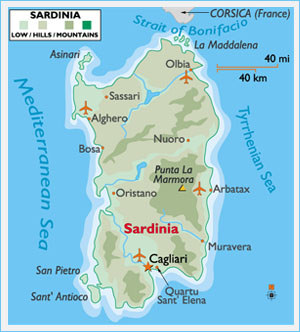Rugged and windswept - Sardinia's north-west coast
 Alghero, Sardinia - Holidaymakers heading for Sardinia are well advised to give the Costa Smeralda, that playing field for the rich and famous, a wide berth and make a bee-line instead for the rugged north-western coast of the Italian island.
Alghero, Sardinia - Holidaymakers heading for Sardinia are well advised to give the Costa Smeralda, that playing field for the rich and famous, a wide berth and make a bee-line instead for the rugged north-western coast of the Italian island.
Between Capo Testa to the far north, with its views of distant Bonifacio on Corsica, and the stunning coast road between Alghero and Bosa in the west there is a wealth of natural splendour to be experienced. The region offers fine beaches, a wooded hinterland and the intriguing Nuraghi, the megalithic conical towers which have come to symbolise Sardinia.
The dramatic granite rocks of Capo Testa around the island's most northerly point at Santa Teresa di Gallura are a pleasant place to stretch the legs. Stiff Mediterranean breezes have shaped these formations down the years, carving all manner of animal-like features into the stone.
A path leads right around the cape with its distinctive white lighthouse, to myriad cliffs and tiny bays. There are bizarre rock formations at every turn and now and again the Mediterranean comes into view. Out on the waves dozens of sailors are messing about in their boats.
Close to the "Costa Paradiso" (Paradise Coast) a road leads through undulating territory past the Gulf of Asinara to the handsome hilltop town of Castelsardo. Ancient walls and a castle perched 100 metres above the sea on a rocky outcrop dominate the scene.
A stroll around the lower town reveals plenty of opportunities to sample the local seafood in time to explore the narrow streets and steps of Castelsardo which exudes a medieval atmosphere.
The busy little town of Stintono is not in the same league but is also worth a visit. The beaches of the Spiagga della Pelosa are beautiful but space can be at a premium here in peak season. From the Capo del Falcone, which is not exactly straightforward to find, is a fine view of Asinara island. Unfortunately the resort suffers from an excess of tourists and property agents.
The abandoned coastal mining town of Argentiera just 40 kilometres to the south provides a stark contrast. The skeletal ruins of buildings once filled with silver miners stand like sentinels in eerie silence. A mining museum is planned using funds from the European Union.
A labyrinth of grottoes with their stalagmites and stalactites at Capo Caccia near Alghero attracts many a visitor and most are keen to view the most magnificent of them all, the Grotta de Nettuno (Neptune's grotto).
It is reachable by boat from Alghero or for the fleet of foot from the top of Capo Caccia promontory via a staircase of more than 600 steps hewn into the rock.
After such a subterranean excursion Alghero's northerly beach is a fine venue for a quiet picnic and also a good vantage point for gazing back at the Capo Caccia before taking in the view of Alghero.
This major holiday destination has managed to combine the role of tourist centre and thriving port. The town has a distinctive Catalan character and is dominated by the impressive Campanile. The Aragonese conquered this part of Sardinia in 1353 and their influence on the town is still present to this day.
The elegant streets of this proud port have a lot to offer, including the Cattedrale di Santa Maria which is is one of the town's architectural highlights and a landmark on the skyline. There are also street signs still written in Catalan. Alghero is altogether a lively town, with watchtowers, alleyways and buskers to entertain the visitors.
After Alghero the road veers away from the coast and instead of peering down at jagged bays from a lofty height the eyes turn to the high plateau with its herds of sheep and the megalithic Nuraghi. The trees hereabouts have been bent out of shape permanently by the eternal winds and it is easy to see which way these blow. (dpa)